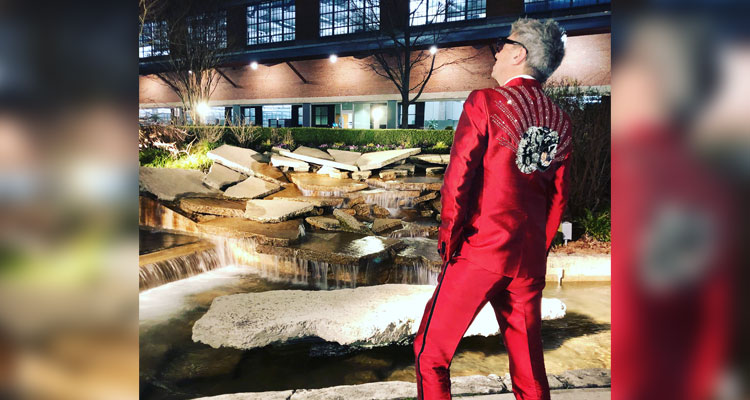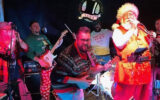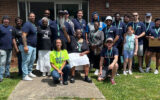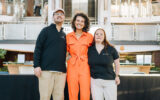How Dr. Richard Bedlack is revolutionizing ALS care through fashion, creativity, and an unshakeable belief in the power of hope
The first thing you notice about Dr. Richard Bedlack isn’t his impressive credentials or his groundbreaking research. It’s his clothes. Walking through the halls of Duke University Medical Center, the neurologist cuts a striking figure in his vibrant, eye-catching outfits—a deliberate choice that serves as both personal armor and professional tool.
“I loved bright, fun clothing from an early age,” Bedlack explains, his voice carrying the warmth of someone who has spent decades delivering hope to patients facing one of medicine’s most devastating diagnoses. “I found that this amplified my positivity and acted like a suit of armor to be able to withstand any negativity I might run into.”
For Bedlack, those clothes are more than just fabric and color. Bedlack’s wardrobe defiantly challenges a disease long shrouded in despair, and they offer hope to ALS (amyotrophic lateral sclerosis, also known as Lou Gehrig’s disease) patients.
A Childhood Curiosity Becomes a Calling
Growing up in a small Connecticut town, young Richard Bedlack was the kind of child who asked questions that made adults pause. “Why do I get dizzy if I roll down a hill? Why does that person shuffle his feet when they walk? Why does her arm shake when she writes?” These weren’t idle curiosities—they were the seeds of a lifelong fascination with the human brain.
His mother, recognizing her son’s insatiable appetite for knowledge, would take him to the local library where a patient librarian helped him find answers to his endless questions. Those library visits led to books, then classes, and eventually to an MD-PhD program at the University of Connecticut, where Bedlack explored neurobiology, neurology, neurosurgery, and psychiatry.
But it was during his neurology residency at Duke that Bedlack encountered the moment that would define his career. His first ALS patient presented what he describes as “the most fascinating and terrible disease I’d ever come across.” What happened next horrified him: the attending physician delivered the devastating news with clinical detachment, telling the patient there was nothing to be done except to “go home and get your affairs in order.”
“I decided to stay at Duke and change the culture around this disease,” Bedlack recalls. It was a decision that would reshape not just his own life, but the lives of countless patients and families facing ALS.
Hope as Medicine
Today, as the founder of the Duke ALS Clinic, Bedlack has built his practice around a radical idea: hope isn’t just an emotion—it’s a treatment. “Across every disease where it has been studied, patients with more hope do better medically,” he explains. “To be the best hope booster, I have to bring positive energy into every interaction.”
This philosophy extends far beyond the walls of his clinic. Bedlack has traveled across the country to participate in his patients’ lives outside of medical appointments—ice bucket challenges, car races, archery competitions, barbecues, poker tournaments, fashion shows, and golf tournaments. These aren’t just social visits; they’re part of his therapeutic approach.
“Watching my patients ‘beat’ ALS spiritually by accomplishing amazing things in spite of it has made me more positive and hopeful,” he says. The relationship is symbiotic—as he gives hope to his patients, they give it back to him.
Fashion as Empowerment
One of Bedlack’s most innovative collaborations emerged from a simple observation: many of his patients found joy and identity in fashion, but as ALS progressed, they could no longer wear the clothes they loved. Most adaptive clothing, he noticed, prioritized function over style.
Enter Stitching Strength, a groundbreaking partnership with design students at NC State University. Working with Sam Pearce from the NC State Fashion School, Bedlack connected students with ALS patients to create clothing that is both stylish and adaptive.
“Several students have now met with people who are living with ALS, listened to what they wanted from a style and adaptability standpoint, and then designed amazing new clothing for them,” Bedlack explains. “I cannot tell you how much it means to see my patients being empowered to wear the things they love again.”
The project has produced moments of pure magic. Bedlack’s favorite memory involves watching one patient’s face light up as students presented a collection specifically inspired by things she loved but could no longer wear. “She felt seen. She felt like she mattered to these students.”
Perhaps even more importantly, the collaboration has shown mainstream designers that adaptive fashion doesn’t require enormous resources. As one student observed, “We started out designing clothes that we would want to wear, and then we made them adaptive. And it wasn’t all that difficult.”
A New Kind of Doctor-Patient Relationship
Bedlack’s approach to research is as revolutionary as his approach to care. Rather than viewing patients as subjects to be studied, he sees them as partners in discovery. “A patient once said to me, ‘we would be so much better if we worked together.’ He was right,” Bedlack reflects. “I now see my patients as research partners. They help me figure out what to study and how to study it. They participate in and even fund most of my research now.”
This collaborative spirit has made Bedlack a subject of fascination himself. A new documentary film chronicles his unique approach to medicine, capturing his interactions with patients and his creative collaborations. The filming process, while rewarding, proved challenging—40 hours of footage condensed into a short film under 40 minutes.
“I want the film’s audience to see that there are ways for clinicians to stay resilient and positive, and to be great hope givers, even in a difficult disease like ALS,” he says. “I want them to see the effect that positivity and hope have on people living with ALS.”
The Weight of Hope
Being an ALS doctor comes with a unique burden. “I will never say that being an ALS doctor is easy,” Bedlack admits. “In fact, I think the stress of it has aged me well beyond my numerical years.” Yet he considers himself blessed to have found a career that employs “the parts of me I love most: my creativity, my fashion, and my love of the brain, to do some good.”
His work has taken him around the world and connected him with extraordinary individuals. It’s this richness of experience that has made him resilient to burnout and kept him positive—essential qualities for someone whose job is to be a “hope booster.”
There’s a quote that Bedlack says summarizes his philosophy: “Carry a light and you need not fear the darkness.”
Looking Forward
Bedlack’s ultimate goal remains audaciously simple: “I want to find a cure for ALS.” But his vision extends beyond the laboratory. If he achieves that goal and still has energy remaining, he plans to work with NC State Fashion School to design and commercialize a line of clothing that is both incredibly stylish and adaptable to everyone with a disability.
The work continues, supported by a community that spans clinicians, students, artists, and families. Through the Duke ALS Clinic website and his Instagram account @stitchingstrength, Bedlack invites others to join the mission—whether through attending documentary screenings, supporting research, or simply spreading the message that hope can be as powerful as any medicine.
In a field where patients are often told there’s nothing to be done, Dr. Richard Bedlack has spent his career proving that there’s always something to be done. Sometimes it’s finding new treatments. Sometimes it’s designing better clothes. Sometimes it’s simply showing up in bright colors and reminding someone that they matter.









